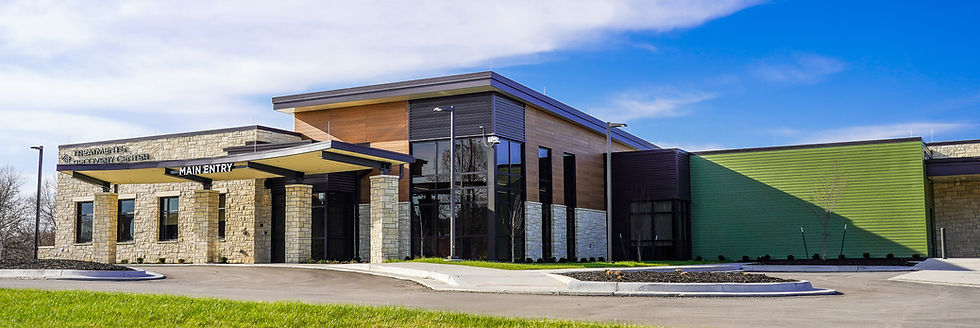Community and healthcare leaders come together to provide groundbreaking collaborative care
- Jeff Burkhead
- Apr 14, 2022
- 5 min read
Updated: Mar 10

Russ Johnson, president and chief executive officer of LMH Health, has worked in healthcare for 38 years. During that time, the way services are delivered has evolved and changed. But some things have stayed the same.
Which makes what is happening in Douglas County not only unique; it’s groundbreaking.
“We have long known the disconnect between mental health, addiction, behavioral health services and acute medicine hasn’t been in the best interests of our patients,” Johnson said. “We recognized we needed to think differently about how we work with our partners in mental health and addiction.”

Several years ago, community and healthcare leaders began looking into an innovative and collaborative system of care. That vision culminated in the development and construction of the Treatment and Recovery Campus of Douglas County, located north of the Community Health Facility at 1000 W. Second St. The final piece of the puzzle will be the Treatment and Recovery Center (TRC), slated to open this summer. The TRC is part of a behavioral health campus, which includes the supportive housing facilities, Transitions and The Cottages at Green Lake which were completed in 2021.
None of this would have happened without forward-thinking leadership and collaboration among nonprofits, healthcare providers and Douglas County government. As well as support from the community in the form of a 2018 quarter-cent sales tax to help fund the construction and operations of the Treatment and Recovery Campus.
“The quarter-cent sales tax initiative that was put before the voters and was approved was huge. Particularly because we don’t have Medicaid expansion in Kansas, which means local taxpayers have to help support health initiatives for their community. We just don’t have those federal funds to help support it,” Sarah Plinsky, Douglas County administrator, said.

The County Commission in recent years has significantly expanded its commitment to behavioral health services and collaboration with local providers to strengthen the system of care. Part of that investment was the hiring of Bob Tryanski for a newly created position as director of Behavioral Health Projects for the County.
“The hiring of Bob was a commitment by the County Commission to move the community’s behavioral health services forward,” Plinsky said.
The development of a crisis center for a community the size of Lawrence is something that is unique.
“We’re integrating substance use treatment and behavioral health,” Plinsky said. “You’d be surprised how often that’s not done. This comprehensive approach doesn’t happen hardly anywhere.”
Spearheading these efforts have been LMH Health, Bert Nash Community Mental Health Center and Douglas County, along with other members of the Behavioral Health Leadership Coalition, a group of organizations dedicated to serving Douglas County residents and ensuring equitable access to behavioral health care and services. The TRC is the shining example and a culmination of these partnerships.
Dr. George Thompson, Medical Director & Executive Director said, “It’s very exciting to be part of something where there’s a clear vision and collaboration like there has been with this project. I’m excited about the opportunity to work with so many wonderful people who are involved with the Treatment and Recovery Center. All of the agencies have come together to really work as partners on this project.”

“We’re very honored and excited to be part of this project,” Bert Nash Center CEO Patrick Schmitz said. “We’re proud to collaborate with our wonderful community partners; we all have our unique missions, yet we all share the common goal of bettering the lives of our fellow citizens. We are pleased to be part of this ongoing work to help get the right services at the right time to those who need it the most.”
To arrive at this point, these community and healthcare partnerships went through some growing pains.
“When you have strong partners with different ways of doing things come together, every now and then you have to give up on something you thought was important,” Johnson said. “That can make a partnership fragment if people aren’t putting care and treatment of patients as the highest goal. When you share that kind of collective goal, you work it out even if you don’t always see things the same way.”
Janette Kirkpatrick, LMH Health vice president – clinical excellence, said partnerships require recognizing compromises must be made.

“Some of these conversations may be difficult,” Kirkpatrick said. “But more than collaboration, it’s an integration of services. We’re all here to serve our patients, provide quality care, and improved experiences for our community members.”
Douglas County and the Bert Nash Center have a long-standing partnership. The County has been invested in the work of the mental health center for many years. The operation of the TRC has added another significant layer to that relationship as well as incorporating LMH Health in the mix.
A nonprofit partnership between the Bert Nash Center and LMH Health, called Behavioral Health Partners, Inc., provides leadership, clinical oversight, and operational management for the TRC. Behavioral Health Partners is governed by a nine-member board of directors. The Bert Nash Center, LMH Health, and the Douglas County Commissioners each appoint three members to the board who may serve three-year terms.
In his role as director of Behavioral Health Projects for the County, Tryanski works closely with all the players.
“The Behavioral Health Leadership Coalition provides guidance, nurturing and relationship building,” Tryanski said. “We have a unique opportunity here to do things that are substantially different from what is happening in the rest of the state and around the country for a community our size.”

Like any working relationship, there can be challenges. When it comes to the TRC, the project has gone through different iterations and plans that have required the partners to make compromises, pivot, and refocus.
“What’s exciting to me is to see the County, Bert Nash, LMH Health and the rest of our partners, working through all the complexities for the best interest of solving a big community challenge,” Tryanski said.
“We have learned a lot from data sharing and collaboration,” Kirkpatrick added. “It has truly been great getting to know our colleagues. We’re all learning through this collaboration. The bottom line is we are treating our patients more efficiently, more effectively. This is the right thing for the community.”
For the Bert Nash Center and LMH Health, they are not only partners, they are neighbors. While they work in proximity to each other, the partnership has also involved breaking down historical barriers.
“Healthcare is best when it’s collaborative. We’ve seen it in how the community has handled the pandemic. We’ve seen it in patients coming to the emergency room who need the expertise of Bert Nash, or DCCA or Heartland RADAC.,” Johnson said. “For me, that is the foundation of why this partnership matters. It feels good to be colleagues, and indeed, friends, between the organizations.”
Bert Nash Center CEO Schmitz shares that sentiment.
“We are humbled to be part of a community that supports the availability of behavioral health services to all of its residents, and we are so appreciative of our agency partners who join us in delivering these critical services,” Schmitz said. “Because of that support and access to services, the destructive cycle of untreated mental illness will be broken, and countless lives will be changed and improved.”
What is happening with development of the Treatment and Recovery Campus and with the TRC coming online this summer, separates Lawrence and Douglas County from many other similarly sized communities.
“This is not like any other center you are going to find in Kansas,” Plinsky said. “It’s not just the building. We are building a system of care. And it’s all for the betterment of the community.”



